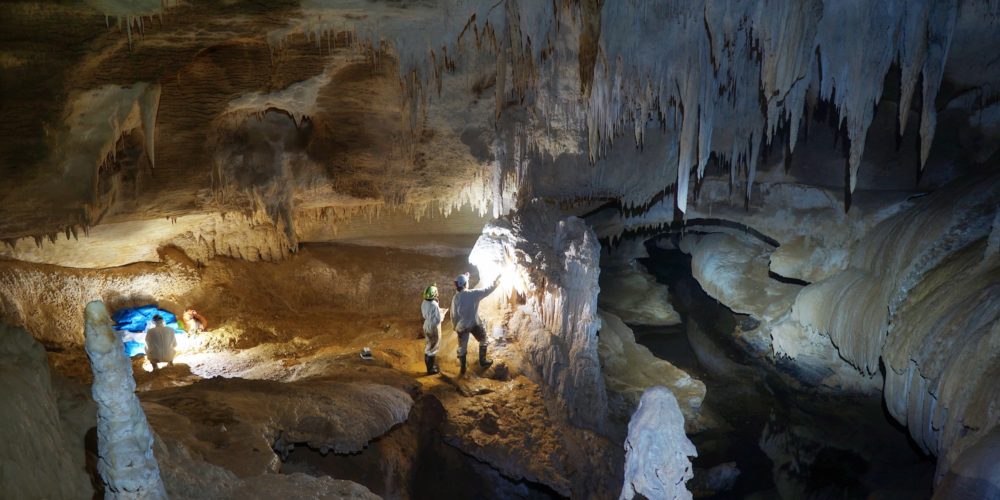Cinthya’s research in the Waipuna cave on dripwater is now published in Hydrology and Earth System Sciences: https://www.hydrol-earth-syst-sci.net/24/3361/2020/

QUEST
QUantitative palaeoEnvironments from SpeleoThems

Cinthya’s research in the Waipuna cave on dripwater is now published in Hydrology and Earth System Sciences: https://www.hydrol-earth-syst-sci.net/24/3361/2020/
Our new tool for paleo-vegetation reconstruction based on lignin oxidation products in stalagmites which has been published in June as a discussion paper is now finally accepted and published in Biogeosciences.
Further reading:
https://www.biogeosciences.net/15/5831/2018/
Quest members from Mainz have published an article about the analysis of lignin oxidation products as vegetation proxies in speleothem and cave drip water samples in the discussion part of Biogeosciences. They developed a sensitive method to analyse the lignin composition of organic traces contained in speleothems. Lignin is a main constituent of woody plants and its composition contains information about the type of vegetation. This method offers new possibilities to reconstruct the vegetation of past millenia since it combines the advantages of lignin analysis as a highly specific vegetation biomarker with the benefits of speleothems as unique terrestrial climate archives.
Further reading:
https://www.biogeosciences-discuss.net/bg-2018-253/
Members of the QUEST team have published a new approach for analysing multivariate proxy records with recurrence networks. The idea is to first consider each proxy separately as a recurrence network, then combine them as layers of a multiplex network, and derive a similarity measure from this resulting multiplex recurrence network. This approach can be used to reveal periods of converging dynamics or very disperse variability, as demonstrated on an example of palaeo vegetation development during the last 16 ka in East Asia.
The “inner composition alignment approach” (IOTA) has been suggested in the past for detecting interdependencies between short time series. QUEST members have now published a new study with a modification of this approach (called mIOTA). The new extension overcomes the drawbacks that IOTA is unable to distinguish between positive and negative correlations, and that the null distribution for IOTA is biased towards higher values. Although the new method cannot detect the direction of the interdependencies (unlike IOTA), it outperforms standard tools for detecting interdependencies (Pearson correlation, Spearman correlation, Kendall’s τ). The method is used to derive econo-climatic networks of interdependencies between economic indicators and climatic variability for Sub-Saharan Africa and South Asia including India.
Further reading:
http://www.ias.ac.in/describe/article/conf/001/01/0051-0060
In a new publication we propose a novel approach for analysing data with uncertainties, which is typical, e.g., in palaeoclimate observations. A time series of single values is replaced by a time series of probabilities; the binary matrix representation of recurrences is then replaced by a matrix of probability values, which represent that a recurrence at a certain time appears. This approach is the base for a novel transition test, applying concepts from recurrence and complex network analysis. We demonstrate the potentials on examples from present-day climate (ENSO), palaeoclimate (Indian summer monsoon), and stock markets.
A new book Caves: Exploring New Zealand’s Subterranean Wilderness will be released in July this year. More information and pre-order available at http://whiopublishing.co.nz/
Our study on the equatorial rain belt displacement by analyzing data from a stalagmite collected in the Yok Balum Cave, Belize, is now published in Scientific Reports.
The first publication by members of the QUEST team (Norbert & Seb) has recently been published in Nature Communications on a giant see-saw in the monsoonal realm. Find the paper here: http://www.nature.com/articles/ncomms12929
A press release has also been published by PIK Potsdam:
https://www.pik-potsdam.de/news/press-releases/giant-see-saw-of-monsoon-rains-detected
enjoy!